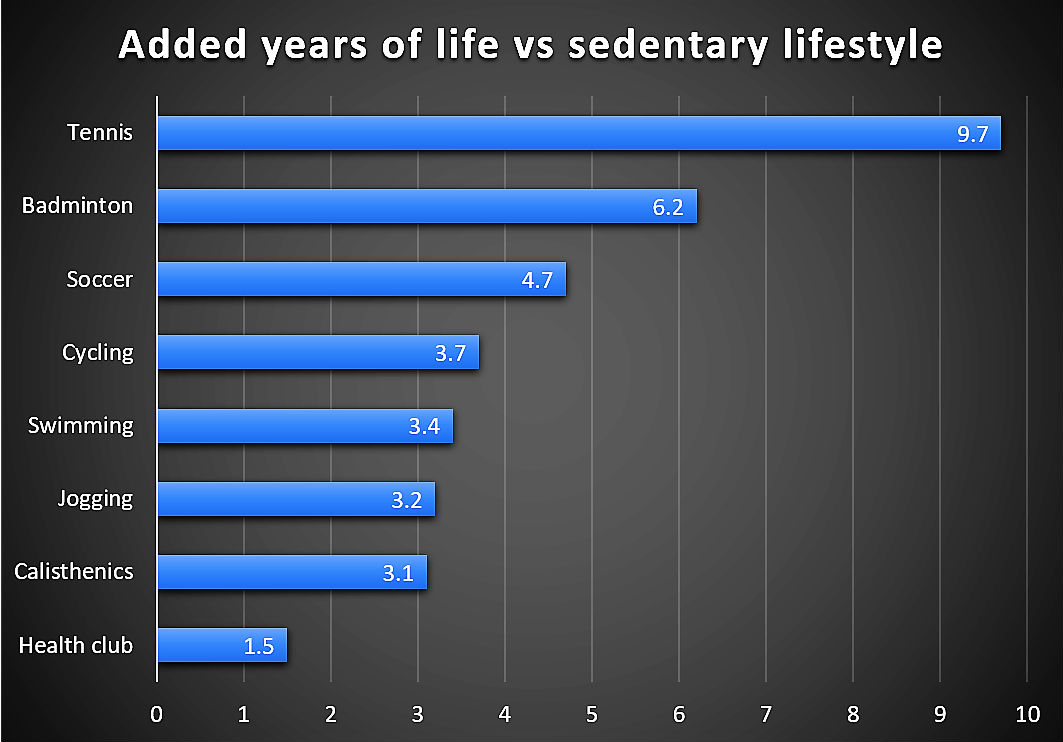So ask your doctor to get you recovered enough to play tennis. I would need all these fixed:
Spasticity in left hand fingers to release the ball for serving.
Ability to pick up and hold two balls in the left hand.
Left arm movement enough to throw ball in air.
Running and stopping without falling over.
Ability to jump the net after winning.
People who play this sport live longest - tennis
John Murphy, MDLinx | February 20, 2019
Any physical activity is better for health
and longevity than no physical activity—but that doesn’t mean that all
physical activities are equally beneficial. Researchers in Denmark have
found that people who take part in one particular type of exercise
generally live longer than people who do other forms of exercise. Which
one is it? Take a guess—the ball’s in your court.
The answer: tennis. People who regularly play tennis have the longest life expectancy compared with people who do other activities, such as jogging, swimming, or bicycling. In fact, tennis players live an average 9.7 years longer than people who do no exercise, according to researchers of the Copenhagen City Heart Study.
“The sports that were linked to the best life expectancy gains typically require interval bursts of exercise using large muscle groups and full body movements, whereas the sports typically performed in a continuous manner showed less impressive life expectancy gains,” wrote corresponding author and cardiologist Peter Schnohr, MD, DMSc, Frederiksberg Hospital, Copenhagen, Denmark, and coauthors in Mayo Clinic Proceedings.
When compared with sedentary behavior, the activities associated with longer years of life expectancy were tennis (9.7 years), badminton (6.2 years), soccer (4.7 years), cycling (3.7 years), swimming (3.4 years), jogging (3.2 years), calisthenics (3.1 years), and health club activities (1.5 years).
However, more time spent on the activity didn’t translate to greater longevity. People who did health club activities (eg, treadmill, elliptical, stair-climber, stationary bikes, and weightlifting) worked out for an average of about 2.5 hours per week, yet tennis players played for only about 1.7 hours per week. Cyclists spent the most time doing their activity—an average of 6.4 hours per week—while swimmers spent the least time at 58 minutes per week.
Sports that require participants to play together and socially interact (tennis, badminton, and soccer, for example) were associated with the best improvements in longevity. On the other hand, activities that are typically more solitary (like jogging, swimming, and cycling) had less longevity benefit.
“The smallest improvement in life expectancy was noted in people who predominantly did health club activities,” Dr. Schnohr and colleagues wrote. “The reason for this could be that their working heart rate was lower than for the other sports, but the reason could also be due to the tendency for people to exercise alone on stationary machines with weights in the health clubs, thereby missing out on the social interaction mandated by racquet sports and soccer, for example.”
He added: “If we are looking for an exercise to improve longevity, we would do well to get together regularly with at least one other person to do some physical activity that feels like fun.”
The authors acknowledged that, although the study has many strengths, one limitation was that it was an observational study, so it doesn’t show whether the relationship between activity and longevity was causal or merely an association.
The study was supported by the Danish Heart Foundation.
The answer: tennis. People who regularly play tennis have the longest life expectancy compared with people who do other activities, such as jogging, swimming, or bicycling. In fact, tennis players live an average 9.7 years longer than people who do no exercise, according to researchers of the Copenhagen City Heart Study.
“The sports that were linked to the best life expectancy gains typically require interval bursts of exercise using large muscle groups and full body movements, whereas the sports typically performed in a continuous manner showed less impressive life expectancy gains,” wrote corresponding author and cardiologist Peter Schnohr, MD, DMSc, Frederiksberg Hospital, Copenhagen, Denmark, and coauthors in Mayo Clinic Proceedings.
Play hard, live less?
For this study, Dr. Schnohr and colleagues reviewed data on 8,577 participants in the Copenhagen City Heart Study, a prospective population study begun in 1991 that followed participants for up to 25 years for all-cause mortality. Among all participants in the study, 12% reported sedentary behavior (no physical activity) and 66% engaged in at least one type of physical activity.When compared with sedentary behavior, the activities associated with longer years of life expectancy were tennis (9.7 years), badminton (6.2 years), soccer (4.7 years), cycling (3.7 years), swimming (3.4 years), jogging (3.2 years), calisthenics (3.1 years), and health club activities (1.5 years).
However, more time spent on the activity didn’t translate to greater longevity. People who did health club activities (eg, treadmill, elliptical, stair-climber, stationary bikes, and weightlifting) worked out for an average of about 2.5 hours per week, yet tennis players played for only about 1.7 hours per week. Cyclists spent the most time doing their activity—an average of 6.4 hours per week—while swimmers spent the least time at 58 minutes per week.
Play together, live longer
Notably, activities that involve more social interaction were associated with the greatest longevity, the researchers found.Sports that require participants to play together and socially interact (tennis, badminton, and soccer, for example) were associated with the best improvements in longevity. On the other hand, activities that are typically more solitary (like jogging, swimming, and cycling) had less longevity benefit.
“The smallest improvement in life expectancy was noted in people who predominantly did health club activities,” Dr. Schnohr and colleagues wrote. “The reason for this could be that their working heart rate was lower than for the other sports, but the reason could also be due to the tendency for people to exercise alone on stationary machines with weights in the health clubs, thereby missing out on the social interaction mandated by racquet sports and soccer, for example.”
Go play with your friends
“It appears that the single most important feature of one’s exercise routine is that it should involve a play-date. Play is Mother Nature’s remedy for stress,” said one of the study authors, cardiologist James O’Keefe, MD, medical director, Charles and Barbara Duboc Cardio Health & Wellness Center, Saint Luke’s Mid America Heart Institute, Kansas City, MO.He added: “If we are looking for an exercise to improve longevity, we would do well to get together regularly with at least one other person to do some physical activity that feels like fun.”
The authors acknowledged that, although the study has many strengths, one limitation was that it was an observational study, so it doesn’t show whether the relationship between activity and longevity was causal or merely an association.
The study was supported by the Danish Heart Foundation.
 People who play this one sport live longer than others. Which one is it?
People who play this one sport live longer than others. Which one is it?
No comments:
Post a Comment